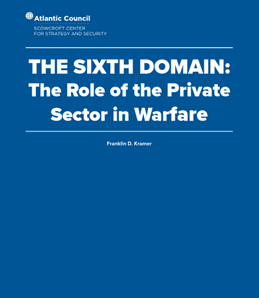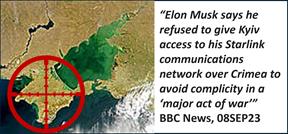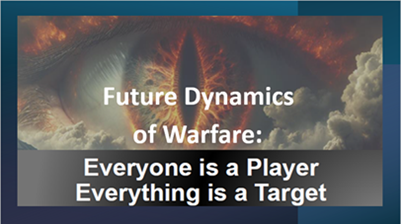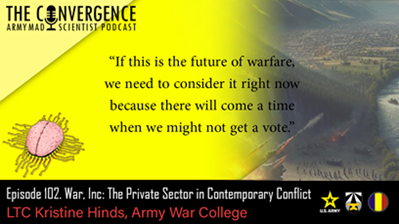[Editor’s Note: The Mad Scientist Laboratory featured LTC Kristine M. Hinds‘ assessment of private sector involvement in future conflicts in “Sixth Domain” – Private Sector Involvement in Future Conflicts last June. While some Army purists have taken exception to the Atlantic Council Scowcroft Center for Strategy and Security‘s use of the term “Sixth Domain” to describe the private sector’s sphere of activities supporting warfighting, no one disputes the vital role that the private sector has played in providing corroborative intelligence via space imagery, effective cyber security, and resilient Command and Control networks — heretofore the domain of public sector defense services and intelligence communities — in Ukraine’s on-going fight against Russian imperialism.
In today’s episode of The Convergence Podcast, Army Mad Scientist sat down with LTC Hinds to address Fifth Generation Warfare, the Sixth Domain, and how we may need to adapt to defend ourselves and our Nation in the evolving Operational Environment — Read on!]
[If the podcast dashboard above is not rendering correctly for you, please click here to listen to the podcast.]
In our latest episode of The Convergence podcast, Army Mad Scientist sat down with LTC Kristine Hinds — a 90A Logistics Corps officer in the U.S. Army Reserve and Future Seminar student at the Army War College — to discuss her work on Team Sullivan’s Travels, what her research revealed, and the implications of a Sixth Domain and Fifth Generation Warfare. The following bullet points highlight key takeaways from our conversation:
-
-
- In focusing on the central theme of “how innovations from contemporary conflicts impact the future dynamics of warfare,” LTC Hinds explored the impacts of non-military or non-federally governed entities in crisis and conflict, specifically those of the private sector.
-
-
-
 Per The Atlantic Council, the sixth domain refers to the private sector’s role in warfare. In its on-going fight with Russia, Ukraine continues to receive private sector support in cyber, communications, and data migration services. The “sixth domain” has emerged as a critical consideration for operational planning and warfighting, not only for the assets and capabilities it can deliver, but also for its associated risk in blurring the distinction between noncombatants and combatants.
Per The Atlantic Council, the sixth domain refers to the private sector’s role in warfare. In its on-going fight with Russia, Ukraine continues to receive private sector support in cyber, communications, and data migration services. The “sixth domain” has emerged as a critical consideration for operational planning and warfighting, not only for the assets and capabilities it can deliver, but also for its associated risk in blurring the distinction between noncombatants and combatants.
-
-
-
- Private sector support is not guaranteed – it can be pulled or even turned into a threat. There is risk in relying too heavily on support that
 can be easily turned off. The private sector’s ability to deny services or withhold information creates the possibility of them adversely impacting strategic, operational, and tactical operations, such as targeting.
can be easily turned off. The private sector’s ability to deny services or withhold information creates the possibility of them adversely impacting strategic, operational, and tactical operations, such as targeting.
- Private sector support is not guaranteed – it can be pulled or even turned into a threat. There is risk in relying too heavily on support that
-
-
-
 Fifth generation warfare loosely describes contemporary conflicts in which tactics like social media influence operations and cyberattacks play a more prominent role in warfare – essentially, the role of the citizen. Early coordination, collaboration, and planning for integrating the private sector and citizens into warfare is necessary prior to the onset of any conflict.
Fifth generation warfare loosely describes contemporary conflicts in which tactics like social media influence operations and cyberattacks play a more prominent role in warfare – essentially, the role of the citizen. Early coordination, collaboration, and planning for integrating the private sector and citizens into warfare is necessary prior to the onset of any conflict.
-
-
-
- Everyone is a player, and everything is a target. A major consideration of integrating the private sector and citizens into warfare is the
 willingness for these traditional noncombatants to potentially become involved kinetically or non-kinetically in a conflict that seemingly no longer has any rules.
willingness for these traditional noncombatants to potentially become involved kinetically or non-kinetically in a conflict that seemingly no longer has any rules.
- Everyone is a player, and everything is a target. A major consideration of integrating the private sector and citizens into warfare is the
-

Stay tuned to the Mad Scientist Laboratory for our next episode of The Convergence on 05 September 2024, when we sit down with “Wolfgang Hagarty” (a nom-de-guerre) to discuss the on-going war in Ukraine, the rapidly evolving Unmanned Aerial Systems (UAS)/Counter-UAS fight, and the overarching impacts of technological innovation on the changing character of warfare.
If you enjoyed today’s post and podcast, check out LTC Kristine Hinds‘ “Sixth Domain” – Private Sector Involvement in Future Conflicts, as well as Team Sullivan’s Travels‘ Future Dynamics of Warfare: Everyone is a Player, Everything is a Target and their comprehensive Final Report.
Explore the TRADOC G-2‘s Operational Environment Enterprise web page, brimming with information on the OE and how our adversaries fight, including:
Our China Landing Zone, full of information regarding our pacing challenge, including ATP 7-100.3, Chinese Tactics, BiteSize China weekly topics, People’s Liberation Army Ground Forces Quick Reference Guide, and our thirty-plus snapshots captured to date addressing what China is learning about the Operational Environment from Russia’s war against Ukraine (note that a DoD Common Access Card [CAC] is required to access this last link).
Our Russia Landing Zone, including the BiteSize Russia weekly topics. If you have a CAC, you’ll be especially interested in reviewing our weekly RUS-UKR Conflict Running Estimates and associated Narratives, capturing what we learned about the contemporary Russian way of war in Ukraine over the past two years and the ramifications for U.S. Army modernization across DOTMLPF-P.
Our Running Estimates SharePoint site (also requires a CAC to access), containing our monthly OE Running Estimates, associated Narratives, and the 2QFY24 and 3QFY24 OE Assessment TRADOC Intelligence Posts (TIPs).
Review the following related Mad Scientist Laboratory wargaming content:
Democratized Intelligence and Russia-Ukraine Conflict: Sign Post to the Future (Part 1), by Kate Kilgore
Insights from Ukraine on the Operational Environment and the Changing Character of Warfare
The OSINT Odyssey: Unmasking Digital Clues and associated podcast, with Shawn Nilius
Space: Challenges and Opportunities
War Laid Bare and What the Joint Force can learn from K-Pop “Stans”, by Matthew Ader
LET’S TWEET, GRANDMA – Weaponizing the Social to Create Information Security, by CDR Sean M. Sullivan
The Future of War is Cyber! by CPT Casey Igo and CPT Christian Turley
Disclaimer: The views expressed in this blog post do not necessarily reflect those of the U.S. Department of Defense, Department of the Army, Army Futures Command (AFC), or Training and Doctrine Command (TRADOC).



